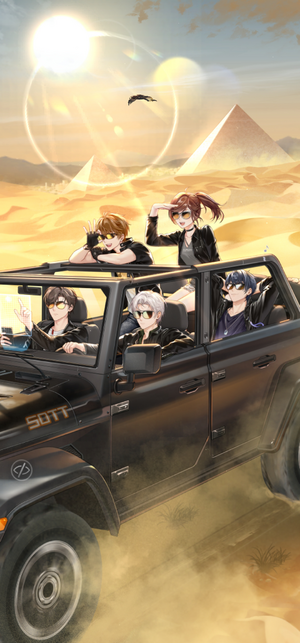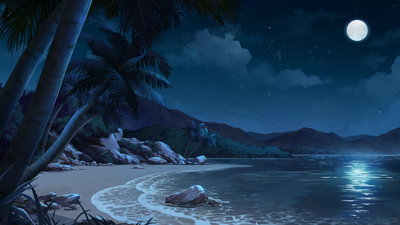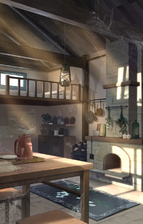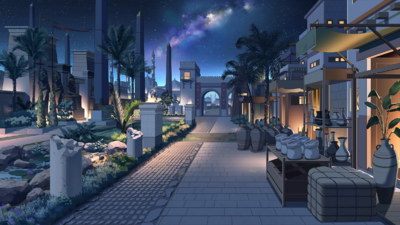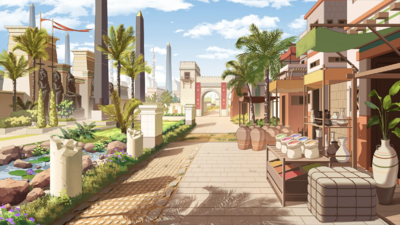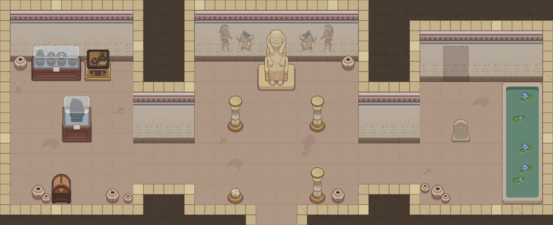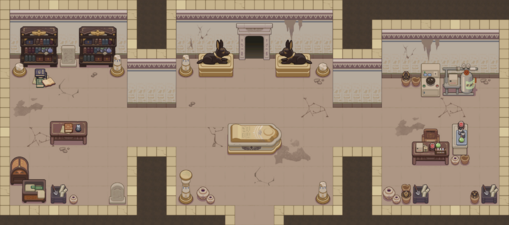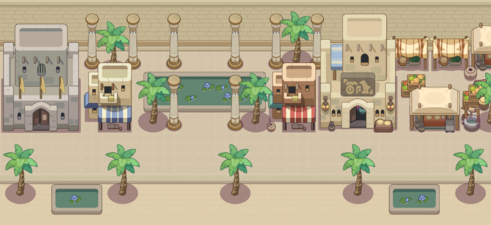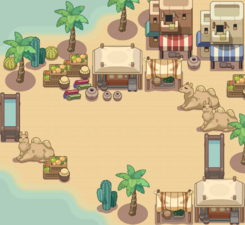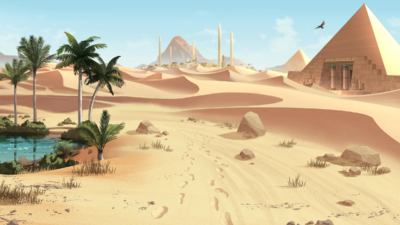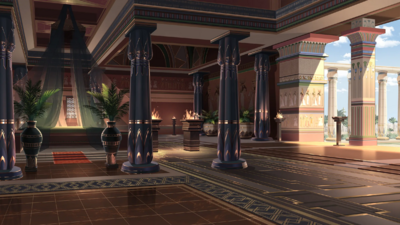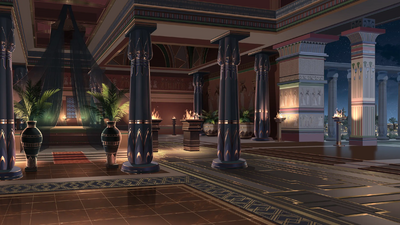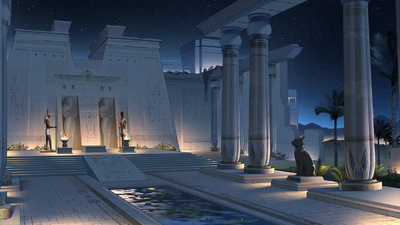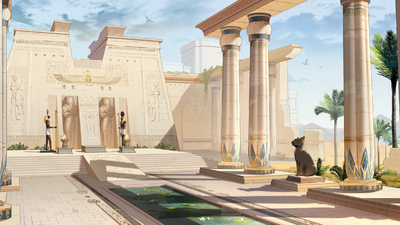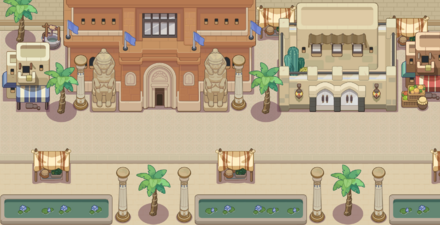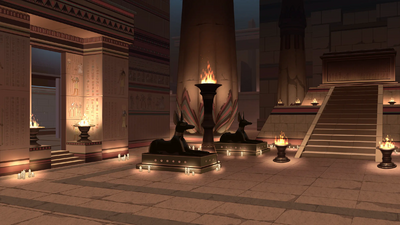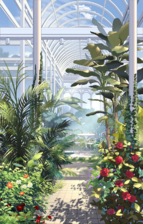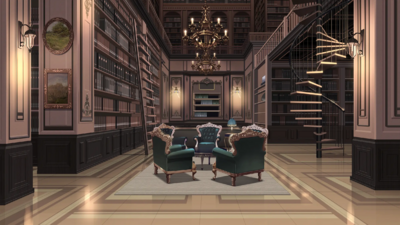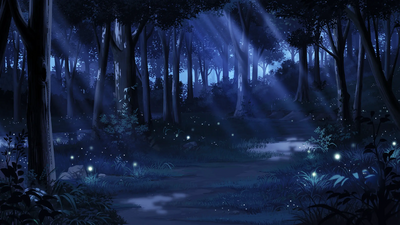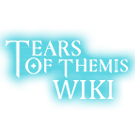Khaimit
Regions[edit | edit source]
Mien[edit | edit source]
The Mien Central Business District is noted to have a "quaint" atmosphere, with stone troughs along the street planted with lotus flowers.[1] The streets of Mien have many stray cats and kittens, many of which are extremely spoiled by passersby who believe cats are embodiments of a god.[2] One of Mien's nicknames is "Mother of the City" due to its position as an economic and cultural center not only in Khaimit, but the entire tropical region. Local crafts in Mien include carpets and clay bowls.[3]
Mien Research Institute[edit | edit source]
Lesser-known than the Rubis Institute, the Mien institute nevertheless has a historical department staffed by at least one expert in ancient pigments.[4]
Rubis[edit | edit source]
Rubis, nicknamed the "City of Palaces,"[3] is a city noted to appear rich in history.[5] It is a two-hour drive from Mien[1] and is host to many of Khaimit's academic facilities. It also hosts a famous temple of Hepharet, which was built on a cliff in an attempt to show the prosperity of Khaimit with elegance.[3]
Local crafts in Rubis are noted to be very different from those of Mien and include shawls, beaded bracelets, and souvenir papyrus. Local citizens revel in the streets with a dance they call the Oriental Dance.[3] Activities available here include line-engraving, a type of traditional painting from ancient times.[6][3]
Rubis Museum[edit | edit source]
The Rubis museum is the largest outdoor museum in the world, which includes the City of the Living and City of the Dead across the Brahma River.[3] Notable artifacts displayed by the Rubis Museum include the mummy of Hepharet.[7]
Rubis Institute[edit | edit source]
The Rubis Institute is built in a quiet location near the museum[3] and holds has many faculties and laboratories, including:
- A chemistry lab, notably staffed by a previous client of Artem Wing from an inter-country advocacy job.[5]
- Various historians, including experts on ancient jewelry[8], paleography,[9] and mummification.[10]
- A heritage restoration department, in charge of the restoration of heavily eroded ancient artifacts.[11]
- An academic journal that periodically publishes papers from the institute with interesting insights[12]
- An unorthodox fragrance lab with glass walls and a great deal of flowers and butterflies within.[13]
Ita Desert[edit | edit source]
GPS coverage in the desert is poor, sometimes leading to travelers getting lost in the desert.[7] The area is sparsely dotted with oases, some of which have fruit-bearing cacti growing nearby.[14] Larger lakes exist in the desert as well, around which a tourist industry has sprung up involving Khaimit's ancient canoes as a boating activity.[15]
Camels, which are said to be very friendly and reliable as long as they're provided with good grazing and clean water,[16] are raised in the settlements around these oases, with camel rearing becoming a family tradition in some families.[3] Scarab colonies also inhabit the desert.[17]
Due to the difficulty involved in doctors reaching the remote settlements in Ita Desert, other learned individuals such as scribes sometimes learn simple medical skills to keep their villages healthy in the face of minor illnesses.[18]
Hessu Ruins[edit | edit source]
Originally discovered by Professor Barr Ralph,[19] the Hessu ruins are about an hour's drive from the Tomb of Ita. They are noted to be very remote and surrounded by desert, making rest and resupply difficult for travelers whose destination lies there. For this reason, locals encourage tourists to stop in Mien before continuing on to the Hessu Ruins.[7] The ruins' exhibition areas have changed little in the last 10-15 years.[20] As the nation of Khaimit believes strongly in freedom and self-discipline, ruins like Hessu are cared for by the locals on a voluntary shift-based system.[21]
Notable artifacts on display in the public area of the Hessu Ruins include a large statue of Hepharet, petroglyphs, carved slabs with ancient script, multiple murals, clay pots, and a large lotus pond.[3]
Beneath Hessu Ruins, kept secret from the public, lies its true original purpose: it served as a tomb for Hepharet's lover, Musen. It's speculated that Hepharet intended to be buried with him upon her death, but she abandoned this idea as years passed and she came to understand the need to give up her personal feelings for the sake of her country.[22] Musen's tomb has a mural inscribed with hieroglyphics, bearing Hepharet's message to Musen:[23]
My beloved, you have gone to the place where God is.
I should have followed your footsteps, but I had to stop here again.
My sweetheart, if you know my heart, remember my name.
The name Hepharet will always belong to you alone.
I am willing to one day be reunited with you again.
We shall reunite on the summer night when the blue lotus is in bloom. Reunite in the morning when the lake is still...
Oh, my lover, may we...
I would give my love to my beloved, but my life can only be tied to the kingdom.
My love... please understand my choice.
From this night on, every blue lotus flower that blooms in the pool is my love for you.
Tomb of Ita[edit | edit source]
Located an hour's drive from the Hessu Ruins, the Tomb of Ita served as the base of operations for a band of thieves decades ago. As they pillaged tombs and cities across Khaimit, they buried their spoils within the tomb, leading the tomb to hide a wide range of artifacts from many places and eras. It's currently under excavation by staff from the Rubis Museum, who are short-handed and accept help from volunteers to clear the debris inside.[7] In ancient times, the Tomb of Ita was a royal tomb for important persons from Khaimit's second to eighth dynasties.
Canat Port[edit | edit source]
Canat Port is noted to be in a similar direction as Hessu Ruins from deep in the Ita Desert, however different roads and routes are necessary to arrive at each destination, leading travelers bound for one to sometimes be lost and sent on the road to the other.[7]
Brahma River[edit | edit source]
The Brahma river runs through both Mien and Rubis.[3]
Culture[edit | edit source]
Cuisine[edit | edit source]
Koshary is a Khaimit specialty made from rice, hollowed noodles, onions, chickpeas, and tomato sauce.[3]
Camel milk tea is popular in Rubis, most highly recommended to be ordered with extra ice, full sugar, and extra pearls. Another variation available is to have it hot with coconut.[8]
Khaimit legend speaks of golden seeds which would prevent hunger forever if found.[3]
Language[edit | edit source]
Ancient Khaimit's language was hieroglyph-based; hieroglyphics can be found on murals, paintings, and pillars throughout the nation.
Additionally, a special script known as the Oracle's Edict, which was believed to be able to communicate with the gods, was known only by High Priests and Pharaohs.[24]
A separate script from the Shert Dynasty is noted to have existed and is said to be relatively uncomplicated. In this dialect, "Nana" is a term of endearment meaning "My Pearl."[18]
Music[edit | edit source]
The sistrum is an instrument unique to ancient Khaimit which could be shaken to be played; when carved with heads or symbols of the gods, this indicated the instrument was primarily used in rituals dedicated to that particular god. However, the remaining players of the sistrum lament that it has lost its significance, revenue, and practicality.[25]
Religion and Mysticism[edit | edit source]
Gods worshipped by the people of Khaimit include Seth, the God of Storms; the ancient pharaohs were revered as representatives of Seth.[20] Metal necklaces known as "Seth's Bone" are popularly worn and are said to be able to break the boundary between life and death[7] and absorb the power of the earth and storm to connect with the consciousness of the Pharaoh.[20]
Euphra was a crocodile god and symbol of bravery, agility, longevity, and water source that worshiped as the main deity of Ladhi, an ancient city-state that no longer exists, formerly in the vicinity of modern Rubis. Ladhi's reverence was so great that crocodiles were commonly mummified there.[10]
Oases in the Ita Desert are thought to be gifts from the God of Heaven.[3]
An unnamed goddess of love is mentioned as having been carved into a sistrum, showing that the sistrum was commonly used in her rituals.[25]
Lotuses are seen as a symbol of reincarnation and resurrection, as well as a bridge to the gods; making a wish in a lotus pond is said to ensure the gods will hear the wish.[3] Blue lotuses in particular, which bloom throughout Khaimit, are seen as a symbol of pure and faithful love and were once worn to pray for a lifetime of love with one's beloved.[26]
Cats are viewed as embodiments of a god among Khaimit's people, leading to strays being a common sight in larger cities. Some of these are decorated with the Eye of Horus around their necks, as both the Eye and cats are said to have magical powers that resist disease and evil.[3]
The hippopotamus was revered as a deity in the Rubis region during the 5th Dynasty due to their habit of choosing places with plentiful water and flourishing grass.[4]
Makeup was seen not only as a tool of beauty, but as a component of worship, with certain motifs associated with the gods as a way to pray for their blessings.[4]
Khaimit's people believe that upon death, their hearts will be weighed against the feather of Ma'at by the gods of the underworld; a person whose heart is lighter than the feather passes on to the afterlife, while a person whose heart is heavier is consumed by evil spirits. They believe that scarabs and scarab-related objects can help a person pass this trial, as scarabs, which represent the laws of the universe, have magic to lessen the weight of the heart.[17] Additionally, jackals are worshiped and are said to be the guardians of the underworld, with royal families commonly placing jackal sculptures in the rooms of their children as prayers for the children's safety.[27]
The Amulet of Life (ankh) is a symbol important to Khaimit, recognized as a symbol of reincarnation,[28] as is the Anubis.[3]
Golden bulls are believed to symbolize wealth and have been used to signify financial officials in Khaimit's past.[11]
Coins are commonly thrown to mummified remains of animals that are revered as deities as a plea for luck.[10]
Day of Prayer[edit | edit source]
A traditional cultural festival taking place monthly, during which the locals typically offer their blessings to the gods they worship.[21]
Hepharet's Return[edit | edit source]
Prior to the events of Secrets of the Tomb, the Hessu Ruins were regarded as an ordinary exhibition like many others in Khaimit,[5] and while the ancient Pharaoh Hepharet was respected and worshipped, her legend was not so widespread and damaging as it would grow to become. This led the Khaimit police to delay in their response to the situation as they believed it was only a natural evolution of civil beliefs until it had reached a fever pitch and spread outside the country.[29]
However, since about six months prior to the arrival of the NXX Investigation Team in Khaimit, Professor Barr Ralph incited the public to believe the past pharaoh Hepharet to be a Messianic figure who could be revived through modern technology[5] and lead Khaimit to greatness once more.[30] During this time, the Hessu Ruins were referred to as a "Holy Land," Seth's Bone necklaces were sold at exorbitant prices as it was believed only those wearing the necklaces would be qualified to listen to the pharaoh's oracle's edict, and citizens were led to believe a cell culture developed by the professor and dumped in Hessu's lotus pond was "miracle water" that could cure all ills. Statues of Hepharet were said to be able to bestow blessings[1] and grant wishes as well.[20]
Part of the fervor around Hepharet's return involved the repurposing of the traditional "Day of Prayer," during which worshippers of Hepharet would gather around a stone slab in the Hessu Ruins,[20] through which Barr Ralph would project an illusion of Hepharet on a cloud of mist emitted from the underground chamber in which he resided.[31]
History[edit | edit source]
1st Dynasty[edit | edit source]
- Kathy v. Al: An ancient legal case; Al borrowed ten gold coins from Kathy and used his father's mummy as collateral.[9] During transport of the mummy, it allegedly fell into the river, and a distraught Al jumped in after it and was never seen again, believed to have been swept away to his death. Years later, a man who looked similar to Al was spotted in a country downstream, living under a new name. While the laws of ancient Khaimit could not prove or punish Al's crimes, a junior officer of the court recorded the case in hopes of preventing similar issues in later generations.[32]
3rd Dynasty[edit | edit source]
- Vishnu: A financial official of the 3rd dynasty who owned a stamp ring carved with a golden bull pattern.[11]
4th Dynasty[edit | edit source]
- Misis: A pharaoh of the 4th dynasty who was buried with a jeweled scarab amulet.[17]
5th Dynasty[edit | edit source]
Khaimit's 5th dynasty was pinpointed to approximately 6,800 years ago.[4]
- Herakon: A pharaoh of the 5th dynasty who buried a clay palette with a hippopotamus pattern and pigments made from turquoise sand with his consort.[4]
- Ngu Debu: The youngest child of his mother, who was a court musician in the 5th Dynasty. Ngu lost his life to illness at age 8, and in her grief, his mother burned all of his belongings except his sistrum, which survives into the modern era.[25]
7th Dynasty[edit | edit source]
- Unnamed prince: Extremely fond of lotus flowers in life, this prince was buried with many lotus-themed items, including an exquisitely carved blue crystal lotus.[26]
8th Dynasty[edit | edit source]
- Abbey: A pharaoh of the 8th Dynasty.[13]
- Nora: A princess of the 8th dynasty who was buried with an eagle necklace composed of lapis lazuli, rutile, blue crystal, and other gemstones. Nora was the youngest daughter of the pharaoh of her era and was more fond of eagles and weaponry than of girlish pursuits such as clothing. She wanted to join the war with her father and brothers at age 8, but she was refused, and she died of illness at age twelve.[8]
- Toru: Sister-in-law to Pharaoh Abbey. Little is known except that she had a silent personality and suffered from insomnia; she carried a jeweled pendant containing balm composed of nightshade, calamus, pine wood, wine, and passion flower to relieve her insomia.[13]
18th Dynasty[edit | edit source]
- Hepharet: An ancient Pharaoh widely revered throughout Khaimit. As the first female Pharaoh, she led her people to greatness and notably even sacrificed her love for the sake of her position, not being able to disclose her lover's identity due to the rules of her era, which restricted the marriage of pharaohs to only other royal families while forbidding marriage to subjects and commoners.[23] A legend around Hepharet claims she was immortal due to her priests having mastered mystical arts to reshape flesh and bone, leaving her able to replace her weak or ill bodies with young and healthy ones.[30]
- Musen: Hepharet's guard and lover,[20] who died of an illness three years into Hepharet's reign.[23]
Unknown Eras and Recent History[edit | edit source]
- Ava Suga: A general of the Shert Dynasty, Ava Suga was known to be a talented fighter since childhood and went on to battle foreign forces in an unknown war. His wife was childhood sweetheart and military advisor Mrs. Foster, whom he called "Nana," which meant "my pearl." After her death, he buried many of his prize possessions with her, including a golden dagger engraved with her name. He then went on to fight ever more courageously on the field of battle until it claimed his life, at which point he released his property to found a village in its place and joined her in her tomb.[18]
- Mrs. Foster: A talented and wise military advisor and childhood sweetheart to General Ava Suga of the Shert Dynasty. While it was rare for women to join the military in ancient Khaimit, her expertise soon silenced any criticism, and she assisted her husband in winning many battles. However, she was physically weak and died of disease at an early age.[18]
- General Nutter: Khaimit was embroiled in war 200 years ago; General Nutter fought as a warlord for Rubis during that time. Shortly after his burial, his tomb was raided by an unknown raider who carried a small pyramid sculpture inscribed with well-wishes from his child, Sitar. The raider triggered traps in Gen. Nutter's tomb and died on site.[33]
- "Daylight Ships": Existing approximately 4,000 years ago, Daylight Ships hailed from an era in which Khaimit was still a grassy swamp full of navigable rivers. Daylight Ships are noted to be good for both passengers and small cargo, and models of them, especially if well-decorated, can be burial objects of high nobility.[15]
- The New Dynasty: A dynasty marked by wars and foreign invasions; the penultimate pharaoh of this dynasty ordered two tons of gold to be buried and left to his descendants in hopes of restoring the dynasty after his death, however the dynasty's collapse soon followed, and the money was collected and used for unknown purposes.[34]
Current Residents[edit | edit source]
- Aman: A middle-aged expert in both modern shipbuilding and ancient ships, possessing a doctorate in both fields; Aman is based out of Oasis Lake in the Ita Desert, but he also works at the Rubis Institute.[15]
- Atta Debu: A sistrum player and member of the 33rd generation of the Debu family. The family is based in Mien and is well known to keep careful track of their ancestry, as well as for maintaining the tradition of the sistrum.[25]
- Barr Ralph: Main article: Barr Ralph
- Big Black: A wolfdog living near an oasis at Ita Desert. After the death of its big brother from illness, he often looks for dog toys to place at his cave home, allegedly hoping it will bring his brother back to life.[27]
- Danny: A child living at an oasis near the Hessu Ruins in Ita Desert; he's lived alone with his mother since his father died in a car accident.[35] His mother is unwell, but she's reluctant to visit doctors since her husband's passing due to the fact that his accident happened while taking her to a doctor.[36]
- Professor Myatt: An expert in the history of ancient jewelry based out of the Rubis institute. Unable to begin his research without a glass of camel milk tea.[8]
- Professor Nephie: An expert on ancient pigments based out of the Mien Research Institute.[4]
- Padilla: A fragrance expert based out of Rubis Institute. Padilla dresses in the traditional clothing of ancient Khaimit and refuses to be associated with anyone who cannot identify scents.[13]
- Petra: A flower seller in Mien and target of Yehya's affections. Frustrated with Yehya's roundabout way of confessing his attraction, she claimed she would only listen if her lotus flowers sold out every day for a month.[37]
- Raiser: A camel rearer in Ita Desert whose family home was pillaged by grave robbers when they recognized a 5th-Dynasty clay jar among his belongings.[38]
- Professor Sally: An expert on heiroglyphics and professor of paleography at Khaimit University.[9] She was a junior classmate of the unnamed Rubis Museum Curator whose studies and career left it impossible for the two of them to have a relationship they both desired; the Curator remarks that they are both near retirement age and that he hopes to try again.[32]
- Scarlett Arkwright: Main article: Scarlett Arkwright
- Professor Urso: A professor of ancient Khaimit linguistics based out of the Rubis Museum.[39]
- Yehya: An officer with the Khaimit police. While he is based out of the police department in Mien, he travels when necessary, having been sighted as far as the Tomb of Ita. Yehya values the freedom of religion of his people and is willing to cooperate with police from other nations when necessary to gain control of an international situation.[29]
Location Gallery[edit | edit source]
| Occurrences | |
|---|---|
| Luke "Overflowing Thoughts" | |
| Occurrences | |
|---|---|
| Secrets of the Tomb Artifact ADV-I: Desert Treasure-Hunting | Villager's Home |
| Occurrences | |
|---|---|
| Artem "Echoes Ablaze" | Commoner's District |
| Luke "Overflowing Thoughts" | Capital City |
| Vyn "Flickering Moonlight" | Central Business District |
| Occurrences | |
|---|---|
| Artem "Echoes Ablaze" | City Gates |
| Artem "Echoes Ablaze" | Commoner's District |
| Artem "Echoes Ablaze" | Prime Minister's Residence |
| Luke "Overflowing Thoughts" | Capital City |
| Marius "Dimly Lit" | Town |
| Secrets of the Tomb Artifact ADV-II: Blue Crystal Lotus | Rubis Street |
| Secrets of the Tomb Artifact BAS-IV: Music of Millenia | Mien Central Business District |
| Secrets of the Tomb Main Story 1-1: First Sight of Mien | |
| Secrets of the Tomb Main Story 1-1: First Sight of Mien | Mien Central Business District |
| Secrets of the Tomb Main Story 1-2: Chance Meeting in Rubis | Mien Central Business District |
| Secrets of the Tomb Main Story 2-3: Truth Behind the Holy Water | Rubis Street |
| Secrets of the Tomb Main Story 3-1: A New Message | |
| Secrets of the Tomb Main Story 4-5: An Ending and a Beginning | |
| Secrets of the Tomb Side Story 4-3: Scarlett's Decision | Mien Central Business District |
| Secrets of the Tomb Side Story 4-4: Yehya's Troubles | Mien Central Business District |
| Occurrences | |
|---|---|
| Secrets of the Tomb Main Story 3-3: Secret behind the Mural | Hessu Ruins |
| Secrets of the Tomb Main Story 4-3: Seeking Truth | Ruin Underground |
| Occurrences | |
|---|---|
| Secrets of the Tomb Artifact Intro-IV: The Stamp of Power | Mien Central Business District |
| Secrets of the Tomb Main Story 1-1: First Sight of Mien | Mien Central Business District |
| Secrets of the Tomb Main Story 2-4: Police's Support | Mien Central Business District |
| Secrets of the Tomb Side Story 1-1: Assistant's Request | Mien Central Business District |
| Secrets of the Tomb Side Story 1-2: Trying Line-Engraving | Mien Central Business District |
| Secrets of the Tomb Side Story 2-1: Sickly Mother | Mien Central Business District |
| Secrets of the Tomb Side Story 2-3: Kittens in Mien | Mien Central Business District |
| Secrets of the Tomb Side Story 3-1: Travelers' Questionnaire | Mien Central Business District |
| Secrets of the Tomb Side Story 3-2: Danny's Wish | Mien Central Business District |
| Secrets of the Tomb Side Story 4-1: Anonymous Diary | Mien Central Business District |
| Secrets of the Tomb Side Story 4-2: Deciphered Diary | Mien Central Business District |
| Occurrences | |
|---|---|
| Luke "Overflowing Thoughts" | Capital City Surroundings |
| Marius "Dimly Lit" | The Wilderness |
| Secrets of the Tomb Artifact ADV-I: Desert Treasure-Hunting | Treasure Map Guide |
| Secrets of the Tomb Artifact BAS-II: Mystery of the Pyramid | Excavation Scene |
| Secrets of the Tomb Artifact BAS-III: Missing Statue | North Desert |
| Secrets of the Tomb Artifact INT-I: Blade of a General | Village |
| Secrets of the Tomb Artifact INT-V: Saving the Mast | Oasis |
| Secrets of the Tomb Artifact Intro-II: The Sacred Scarab | Scarab's Habitat |
| Secrets of the Tomb Main Story Prologue | Desert Outskirts |
| Secrets of the Tomb Side Story 2-2: Scarlett Arkwright's Feelings | |
| Occurrences | |
|---|---|
| Artem "Echoes Ablaze" | Meeting Hall |
| Artem "Echoes Ablaze" | Study |
| Luke "Overflowing Thoughts" | Ceremony Hall |
| Luke "Overflowing Thoughts" | Palace |
| Marius "Dimly Lit" | Palace |
| Marius "Dimly Lit" | Temple |
| Marius "Dimly Lit" | The Pharaoh's Quarters |
| Vyn "Flickering Moonlight" | Ceremony Hall |
| Vyn "Flickering Moonlight" | Vyn's Palace |
| Occurrences | |
|---|---|
| Marius "Dimly Lit" | Palace |
| Marius "Dimly Lit" | The Pharaoh's Quarters |
| Occurrences | |
|---|---|
| Artem "Echoes Ablaze" | High in the Temple |
| Artem "Echoes Ablaze" | Temple |
| Luke "Overflowing Thoughts" | Amarna Temple |
| Marius "Dimly Lit" | Outside the Palace |
| Occurrences | |
|---|---|
| Artem "Echoes Ablaze" | Garden |
| Artem "Echoes Ablaze" | Temple |
| Luke "Overflowing Thoughts" | Amarna Temple |
| Secrets of the Tomb Artifact Intro-I: Exploration Introduction | |
| Vyn "Flickering Moonlight" | Altar |
| Vyn "Flickering Moonlight" | Outside the Ceremony Hall |
| Occurrences | |
|---|---|
| Secrets of the Tomb Artifact BAS-III: Missing Statue | Rubis Street |
| Secrets of the Tomb Artifact INT-III: The Crocodile's Body | Rubis Street |
| Secrets of the Tomb Artifact Intro-II: The Sacred Scarab | Rubis Street |
| Secrets of the Tomb Artifact Intro-III: Eagle of Khaimit | Rubis Street |
| Secrets of the Tomb Main Story 1-2: Chance Meeting in Rubis | Rubis Street |
| Secrets of the Tomb Main Story 2-3: Truth Behind the Holy Water | Rubis Street |
| Secrets of the Tomb Main Story 4-1: A New Clue | Rubis Street |
| Secrets of the Tomb Side Story 1-1: Assistant's Request | Rubis Street |
| Secrets of the Tomb Side Story 1-2: Trying Line-Engraving | Rubis Street |
| Secrets of the Tomb Side Story 4-1: Anonymous Diary | Rubis Street |
| Secrets of the Tomb Side Story 4-2: Deciphered Diary | Rubis Street |
| Secrets of the Tomb Side Story 4-4: Yehya's Troubles | Rubis Street |
| Occurrences | |
|---|---|
| Secrets of the Tomb Artifact BAS-V: A Fascinating Aroma | Padilla's Lab |
| Occurrences | |
|---|---|
| Secrets of the Tomb Main Story 2-4: Police's Support | Mien Police Department |
| Secrets of the Tomb Main Story 3-1: A New Message | Mien Police Department |
| Secrets of the Tomb Main Story 4-2: Yehya's Request | Mien Police Department |
| Secrets of the Tomb Main Story 4-5: An Ending and a Beginning | Mien Police Department |
| Occurrences | |
|---|---|
| Vyn "Flickering Moonlight" | Temple Surroundings |
References[edit | edit source]
- ↑ 1.0 1.1 1.2 Secrets of the Tomb Main Story 1-1: First Sight of Mien
- ↑ Secrets of the Tomb Side Story 2-3: Kittens in Mien
- ↑ 3.00 3.01 3.02 3.03 3.04 3.05 3.06 3.07 3.08 3.09 3.10 3.11 3.12 3.13 3.14 3.15 Secrets of the Tomb RPG Exploration
- ↑ 4.0 4.1 4.2 4.3 4.4 4.5 Secrets of the Tomb Artifact BAS-I: Body Painting
- ↑ 5.0 5.1 5.2 5.3 Secrets of the Tomb Main Story 1-2: Chance Meeting in Rubis
- ↑ Secrets of the Tomb Side Story 1-2: Trying Line-Engraving
- ↑ 7.0 7.1 7.2 7.3 7.4 7.5 Secrets of the Tomb Main Story Prologue
- ↑ 8.0 8.1 8.2 8.3 Secrets of the Tomb Artifact Intro-III: Eagle of Khaimit
- ↑ 9.0 9.1 9.2 Secrets of the Tomb Artifact INT-II: The Decryption
- ↑ 10.0 10.1 10.2 Secrets of the Tomb Artifact INT-III: The Crocodile's Body
- ↑ 11.0 11.1 11.2 Secrets of the Tomb Artifact Intro-IV: The Stamp of Power
- ↑ Secrets of the Tomb Main Story 4-1: A New Clue
- ↑ 13.0 13.1 13.2 13.3 Secrets of the Tomb Artifact BAS-V: A Fascinating Aroma
- ↑ Secrets of the Tomb Side Story 1-3: Camel Owner's Request
- ↑ 15.0 15.1 15.2 Secrets of the Tomb Artifact INT-V: Saving the Mast
- ↑ Secrets of the Tomb Side Story 3-3: Camel Care
- ↑ 17.0 17.1 17.2 Secrets of the Tomb Artifact Intro-II: The Sacred Scarab
- ↑ 18.0 18.1 18.2 18.3 Secrets of the Tomb Artifact INT-I: Blade of a General
- ↑ Secrets of the Tomb Main Story 3-1: A New Message
- ↑ 20.0 20.1 20.2 20.3 20.4 20.5 Secrets of the Tomb Main Story 1-3: Hessu's Miracle
- ↑ 21.0 21.1 Secrets of the Tomb Main Story 1-4: Secret of the Slab
- ↑ Secrets of the Tomb Main Story 4-4: Between Secrets
- ↑ 23.0 23.1 23.2 Secrets of the Tomb Main Story 3-3: Secret behind the Mural
- ↑ Secrets of the Tomb Side Story 4-1: Anonymous Diary
- ↑ 25.0 25.1 25.2 25.3 Secrets of the Tomb Artifact BAS-IV: Music of Millenia
- ↑ 26.0 26.1 Secrets of the Tomb Artifact ADV-II: Blue Crystal Lotus
- ↑ 27.0 27.1 Secrets of the Tomb Artifact BAS-III: Missing Statue
- ↑ Secrets of the Tomb Main Story 4-3: Seeking Truth
- ↑ 29.0 29.1 Secrets of the Tomb Main Story 2-4: Police's Support
- ↑ 30.0 30.1 Secrets of the Tomb Main Story 2-1: Day of Prayer Miracle
- ↑ Secrets of the Tomb Main Story 2-2: A So-called Miracle
- ↑ 32.0 32.1 Secrets of the Tomb Artifact INT-IV: Secret of the Slab
- ↑ Secrets of the Tomb Artifact BAS-II: Mystery of the Pyramid
- ↑ Secrets of the Tomb Artifact ADV-I: Desert Treasure-Hunting
- ↑ Secrets of the Tomb Side Story 2-1: Sickly Mother
- ↑ Secrets of the Tomb Side Story 3-2: Danny's Wish
- ↑ Secrets of the Tomb Side Story 4-4: Yehya's Troubles
- ↑ Secrets of the Tomb Artifact Intro-V: Missing Clay Pot
- ↑ Secrets of the Tomb Side Story 4-1: Anonymous Diary
